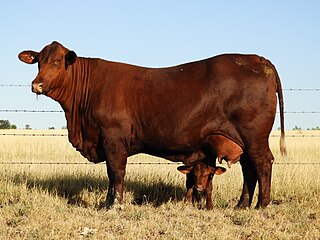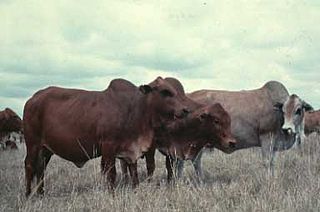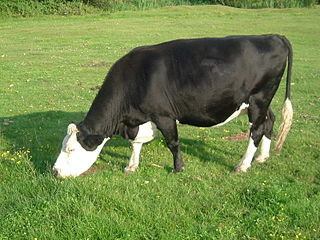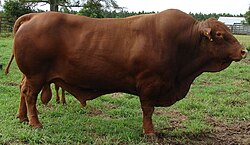
The Canchim is a breed of beef cattle developed in Central Brazil by crossing European Charolais cattle with Indubrazil cattle already kept in Brazil where Asian Zebu type cattle are best suited to the tropical conditions. When compared with Zebu bulls, Canchim bulls produce the same number of calves, but heavier and of superior quality. Compared to European breeds, the Canchim bull produces calves with the same weight but in larger numbers. The fast-growing progeny, from crossbred zebu cows with Canchim bulls, can be slaughtered at 18 months old from feedlots after weaning, up to 24 months old from feedlots after grazing and at 30 months from grazing on the range.

The zebu, sometimes known in the plural as indicine cattle or humped cattle, is a species or subspecies of domestic cattle originating in the Indian sub-continent. Zebu are characterised by a fatty hump on their shoulders, a large dewlap, and sometimes drooping ears. They are well adapted to withstanding high temperatures, and are farmed throughout the tropical countries, both as pure zebu and as hybrids with taurine cattle, the other main type of domestic cattle. Zebu are used as draught and riding animals, dairy cattle, and beef cattle, as well as for byproducts such as hides and dung for fuel and manure. Some small breeds such as the miniature zebu are also kept as pets. In 1999, researchers at Texas A&M University successfully cloned a zebu.

The Texas Longhorn is an American breed of beef cattle, characterized by its long horns, which can span more than 8 ft (2.4 m) from tip to tip. It derives from cattle brought from the Iberian Peninsula to the Americas by Spanish conquistadores from the time of the Second Voyage of Christopher Columbus until about 1512. For hundreds of years the cattle lived a semi-feral existence on the rangelands; they have a higher tolerance of heat and drought than most European breeds.

The Red Poll is a dual-purpose breed of cattle developed in England in the latter half of the 19th century. The Red Poll is a cross of the Norfolk Red beef cattle and Suffolk Dun dairy cattle breeds.

The Highland is a Scottish breed of rustic beef cattle. It originated in the Scottish Highlands and the Western Islands of Scotland and has long horns and a long shaggy coat. It is a hardy breed, able to withstand the intemperate conditions in the region. The first herd-book dates from 1885; two types – a smaller island type, usually black, and a larger mainland type, usually dun – were registered as a single breed. It is reared primarily for beef, and has been exported to several other countries.

Holstein Friesians are a breed of dairy cattle that originated in the Dutch provinces of North Holland and Friesland, and Schleswig-Holstein in Northern Germany. They are known as the world's highest-producing dairy animals.

The Murray Grey is an Australian breed of polled beef cattle. It originated between 1905 and 1917 in the upper Murray River valley, on the border between New South Wales and Victoria. It is similar in appearance to the Aberdeen Angus, from which it largely derives, but is grey, silver or dun in colour.

The Afrikaner, also known as the Africander, is a breed of taurine-indicine ("Sanga") cattle indigenous to South Africa.

A bovid hybrid is a hybrid of two different members of the bovid family.

The Limousin, French: Limousine, is a French breed of beef cattle from the Limousin and Marche regions of France. It was formerly used mainly as a draught animal, but in modern times is reared for beef. A herd-book was established in France in 1886. With the mechanisation of agriculture in the twentieth century, numbers declined. In the 1960s there were still more than 250 000 head, but the future of the breed was not clear; it was proposed that it be merged with the other blonde draught breeds of south-western France – the Blonde des Pyrénées, the Blonde de Quercy and the Garonnaise – to form the new Blonde d'Aquitaine. Instead, a breeders' association was formed; new importance was given to extensive management, to performance recording and to exports. In the twenty-first century the Limousin is the second-most numerous beef breed in France after the Charolais. It is a world breed, raised in about eighty countries round the world, many of which have breed associations.

The Shorthorn breed of cattle originated in the North East of England in the late eighteenth century. The breed was developed as dual-purpose, suitable for both dairy and beef production; however, certain blood lines within the breed always emphasised one quality or the other. Over time, these different lines diverged, and by the second half of the twentieth century, two separate breeds had developed – the Beef Shorthorn, and the Milking Shorthorn. All Shorthorn cattle are coloured red, white, or roan, although roan cattle are preferred by some, and completely white animals are not common. However, one type of Shorthorn has been bred to be consistently white – the Whitebred Shorthorn, which was developed to cross with black Galloway cattle to produce a popular blue roan crossbreed, the Blue Grey.

The Santa Gertrudis is an American breed of beef cattle. It is a taurine-indicine hybrid breed, descended from both zebu and European cattle. It was bred in the early twentieth century in Texas, and received official recognition in 1940. It has been exported to many countries including Australia, Brazil and South Africa, and has contributed to the development of a number of modern breeds, among them the Barzona and the Droughtmaster.

Boran cattle are a popular Zebu beef breed in eastern Africa.

The Black Hereford is a crossbreed of beef cattle produced in Britain and Ireland with Hereford beef bulls with Holstein-Friesian dairy cows. Black Herefords are not usually maintained from generation to generation, but are constantly produced as a byproduct of dairy farming as a terminal cross. They are one of the most common types of beef cattle in Britain and Ireland, outnumbering many pure beef breeds.

Sanga cattle is the collective name for indigenous cattle of sub-Saharan Africa. They are sometimes identified as a subspecies with the scientific name Bos taurus africanus. Their history of domestication and their origins in relation to taurine cattle, zebu cattle, and native African varieties of the ancestral aurochs are a matter of debate.

N'Dama is a breed of cattle from West Africa. Other names for them include Boenca or Boyenca (Guinea-Bissau), Fouta Jallon, Djallonké or Djallonké cattle, Fouta Longhorn, Fouta Malinke, Futa, Malinke, Mandingo (Liberia), and N'Dama Petite (Senegal). Originating in the Guinea highlands, they are also found in southern Senegal, Guinea-Bissau, the Gambia, Mali, Ivory Coast, Liberia, Nigeria, and Sierra Leone. They are trypanotolerant, allowing them to be kept in tsetse fly-infested areas. They also show superior resistance to ticks and the diseases they carry and to Haemonchus contortus stomach worms.

Yakutian cattle, Саха ынаҕа in the Sakha language, are a cattle landrace bred north of the Arctic Circle in the Republic of Sakha. They are noted for their extreme hardiness and tolerance towards freezing temperatures.

The Red Brangus is an American breed of hybrid beef cattle, with both taurine and indicine genetic heritage. Development began in Texas in the 1940s. It is a colour variant of the Brangus, a hybrid of American Angus and Brahman cattle, and differs from it only in colour. There are two herd-books, one international and one American. For international registration the animal must be of 5/8 Angus and 3/8 Brahman descent; in the United States, it may be any mix of the two breeds, but registration is conditional on inspection.

The red and black coated Arado cattle are small and hardy. They are the most common cattle variety in the north Ethiopian highlands. The Arado breed is part of the Zenga breed group. It is essentially reared for draught power, particularly tillage. The breed feeds mainly on crop residues; it is adapted to seasonal feed shortages. This breed is often cross-bred through bull and artificial insemination services.

The long-horned Raya cattle are a breed of cattle common in the Tigray Region of Ethiopia. The Raya cattle have red and black coat colours. Bulls and oxen have thick and long horns and a cervicothoracic hump; cows have medium, thin horns. Raya cattle are closely related to the Afar cattle; this is a result of historical cattle raiding by the Raya people. The Raya cattle are however adapted to draught animals for tillage in the croplands of the highlands.




















